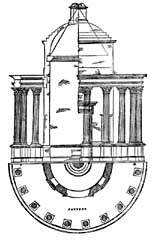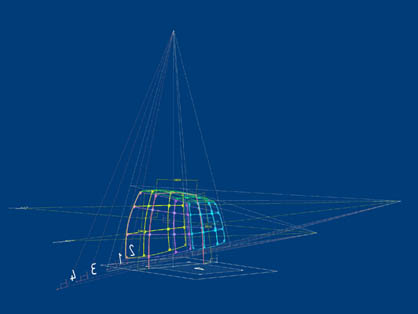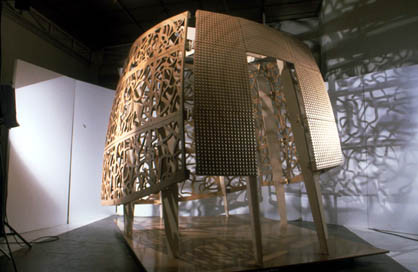|
|
| home > files |
| Perspective,
Projections, and Design: Technologies of Architectural Representation Mario Carpo |
|
|
| home > files |
| Perspective,
Projections, and Design: Technologies of Architectural Representation Mario Carpo |
| Dal
12 al 14 giugno scorso si è svolto a Tours, presso il Centre d'études
supérieures de la Renaissance, il congresso Perspective,
Projections, and Design Technologies of Architectural Representation.
L'iniziativa, dedicata ad ampio raggio allo studio del rapporto tra
geometria architettonica e rappresentazione, è stata organizzata da
una nutrita serie di prestigiose istituzioni, tra cui: Bureau de la
recherche architecturale et urbaine (Direction de l'architecture et
du patrimoine, Ministère de la culture et communication); Centre d'études
supérieures de la Renaissance, Université François-Rabelais, Tours;
CNRS; in collaborazione con Canadian Centre for Architecture, Montréal;
Institut Français d'Architecture, Paris; The Getty Research Institute,
Los Angeles; Institut national d'histoire de l'art, Paris. Mario Carpo,
che ha organizzato il congresso insieme a Frédérique Lemerle-Pauwels,
propone ai lettori di ARCH'IT un consuntivo dell'incontro. |
||||
 Daniele Barbaro, La pratica della perspettiva, (Venezia, 1568-69): 154. |
The
conference "Perspective, Projections and Design: Technologies of Architectural
Representation" was held in Tours, at the Centre d'études supérieures
de la Renaissance, last June, 12 to 14 - in spite of the perturbed state
of the French transportation system, then on strike, which put the city
of Tours at a longer distance from Paris, travel-wise, than it would
normally have been. The conference was the second in a series inaugurated
by the Getty Research Institute in Los Angeles last year (May 2002),
and it was co-organized by Frédérique Lemerle on behalf of the French
CNRS, and by Mario Carpo on behalf of the Bureau de la Recherche Architecturale
(Ministère de la Culture, Paris), with additional support coming from
the Canadian Centre for Architecture (Montréal), the Institut Français
d'Architecture (Paris), and the Institut National d'Histoire de l'Art
(Paris). Speakers included (in the order of their presentations): Eric
Lengereau, Jeanne Pfeiffer, Filippo Camerota (in absentia), Joël Sakarovitch,
Thierry Mandoul, Bernard Cache, Yves Pauwels, Pierre Gros, Sabine Frommel,
Pietro Roccasecca, Emilie d'Orgeix, Philippe Potié, Louise Pelletier,
Alberto Perez-Gomez, Alice Thomine, Hubert Damisch, Mario Carpo, Roberta
Panzanelli, Antoine Picon, Jean-Louis Cohen, Frédéric Nantois, and Daniel
Estévez. |
[18sep2003] | ||
| The
conference program addressed a number of well-known issues in the history
of architectural representations, first and foremost the origin of parallel
and central projections in architectural drawings and design (see the
call for papers, appended). Although a vast literature exists on the
early-modern invention of central projections (or linear perspective),
the history of parallel projections in architecture has so far received
little scholarly attention. Plans, elevations and sections of buildings
appear to have been in use from time immemorial -first as surveys of
existing buildings, then as designs of buildings to be-but the mathematical
principles underpinning parallel projections are recent. Perspective
emulates vision by altering measurements, which makes it unsuitable
for technical purposes; likewise, drawings in parallel projections must
be precisely drawn to scale in order to register true measurements,
either analog or number-based. Axonometric drawings, an adaption of
parallel projections which was of capital importance for architectural
Modernism in the twentieth century (up to an including some more recent
developments) is an intriguing and still largely unexplored field of
investigation. As Jean-Louis Cohen recalled during the round table which concluded the conference, "Convergenze Parallele", a notorious oxymoron current in the Italian political lingo of the late twentieth century, aptly describes the complexities and contradictions pertaining to the visual representation of infinity, its computation, and its translation into non-mathematical epiphanies - an epistemic challenge that curiously associates Leon Battista Alberti, Desargues, Leibniz, and Aldo Moro (who invented that formula in 1960). One of the purposes of the conference was to initiate a dialogue among scholars and theoreticians that share a common interest in the technologies of architectural representation, but from different vantage points--architectural history, the history of geometry and of mathematics, and contemporary design theory. For the alliance between architecture and geometry has experienced a recent revival of sorts, and many contemporary architects are enthusiastic users of advanced geometrical tools.  Bernard Cache, Pavillion Philibert de l'Orme (2001); a diagram of the projective cube that generates the geometry of the pavillion (copyright Bernard Cache). |
||||
| From
the Italian Renaissance on, numeracy gradually replaced geometry as
the main tool for quantification in architectural design. But this trend
was forcefully reversed in more recent times, following a cultural and
technical shift that took place in the early 1990s. A new quest for
continuity in forms then crossed paths with computer aided design, and
architects and theoreticians then discovered topology, an abstract branch
of higher mathematics that had till then seldom interfered with the
mostly Euclidian labors of building. Topological transformations are
the most general of geometrical operations, and subsume all others.
They also generate "morphing" forms which were easily manipulated and
visualized by the earliest programs of digital imaging - first introduced
by the movie industry, then adopted by designers. Although the excitement for "topological" forms that characterized the architectural avant-garde at the end of the millennium has cooled off in more recent times, the heritage of those experiments remains significant. The love story between designers and topological geometry has reinforced the awareness of a technical interconnection between the forms that we can conceive, represent, and manufacture. It is difficult to imagine forms that we can not draw, just as it is difficult to build forms that we can not measure. The technologies, tools, and devices that we use for drawing and measuring (on paper or without) may thus determine architectural form.  Bernard Cache, Pavillion Philibert de l'Orme (2001). |
||||
| All
ages of fast technical change incline towards technological determinism.
Yet we should not forget that our ambition to build is the primary raison
d'être for the technologies (this includes geometry) that are in use
at any given time. Technologies that are not in use are by definition
useless: either they have already been discarded, or they have not yet
been invented. New tools can only spread when someone is determined
to make something of them. Topological geometry had been around for
almost a century before architects began to take notice. The dialectical
pattern of mutual interactions between architectural forms and technologies
of representation, so conspicuous for the last ten years, is in fact
a timeless invariant of architectural history. This conference offered
some eloquent examples of it. testo Mario Carpo |
||||